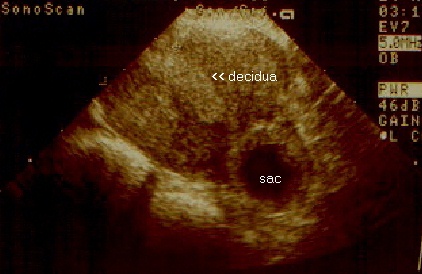
Although ectopic pregnancies occur everywhere from the cervix to the upper abdomen, 97 percent occur in the fallopian tube.
The clinical importance of ectopic pregnancy stems from the high mortality of ruptured ectopic pregnancy (0.1%) and the relatively high and increasing incidence of such pregnancies.
In recent years, the sensitivity of Serum HCG assays has improved such that virtually all ectopic pregnancies yield a positive result. Routine HCG measurement in patients with pelvic pain, vaginal bleeding, and unexplained adnexal mass allows confident definition of patients at risk for ectopic pregnancy.
First: Direct visualization of ectopic gestation
Ideally, ultrasound can directly localizing the gestation outside the uterus. In practice, difficulties in visualizing the adnexa and distortion of the gestation sac mean only 25-60% display unequivocal ectopic gestations. Because of this, the adnexal findings are usually considered of secondary importance (except when a definite embryo or yolk sac can be shown). More about adnexal findings later.
Second: Absence of intrauterine gestation.
Because the uterus is reliably seen at high resolution in all patients, any intrauterine pregnancy of sufficient size will be seen by ultrasound.
The most important single observation in evaluation of suspected ectopic pregnancy is the presence or absence of an intrauterine pregnancy.
Since the co-existence of both intrauterine and ectopic pregnancy is rare (1 in 4-30,000), in most cases the presence of an intrauterine pregnancy reduces the probability of ectopic gestation below the level of clinical concern.
None the less, it is good practice to carefully evaluate the adnexa for alternative causes of pelvic pain, and to identify the rare heterotopic twin pregnancy.
a.) Gestation of 5 week menstrual age or more. Gestations of less then 5 weeks are not reliably seen by ultrasound. Since menstrual age is not 100% accurate, verification by serum HCG levels above the "discrimination" level of 2000 mIu/ml. (1 IS, 3rd IRP) suggests that an intrauterine gestation below the ultrasound detection threshold is present.
Note: In this case, diagnostic laproscopy is often indicated because of a high probability of ectopic pregnancy. None the less, as many as 35% of patients with a value of 2000 units and negative ultrasoud will have ongoing intrauterine pregnancy. Because of this, negative ultrasound and HCG > 2000 units should not be the basis for therapeutic termination, such as methotrexate injection, but only further diagnostic manueuvers.
b.) No clinical evidence of recent complete spontaneous abortion. In this setting a small number (about 10%) will have residual serum HCG values despite recent complete spontaneous loss of an intrauterine pregnancy.
This presumptive diagnosis should lead to Laparoscopic visualization of the tubes, with appropriate therapy.
Return to Radiology for Medical Students Index